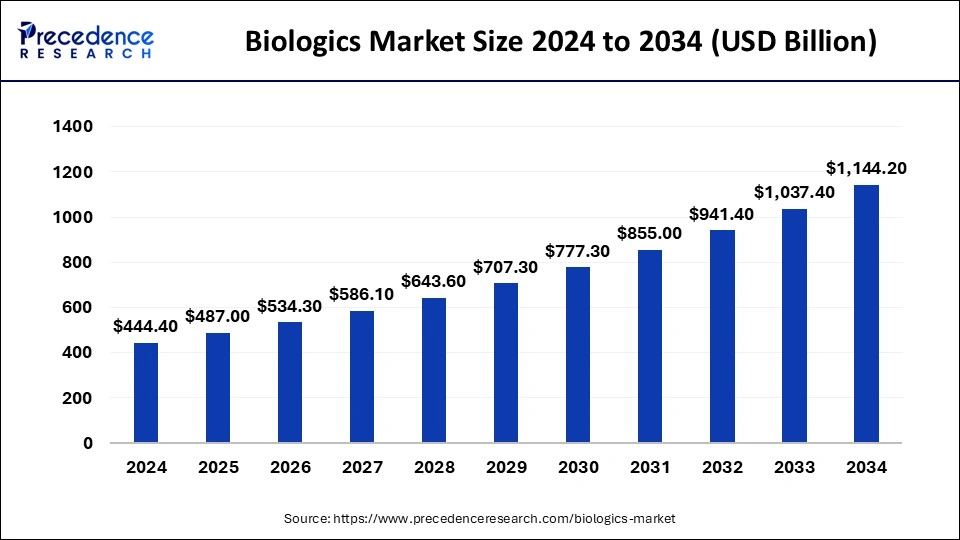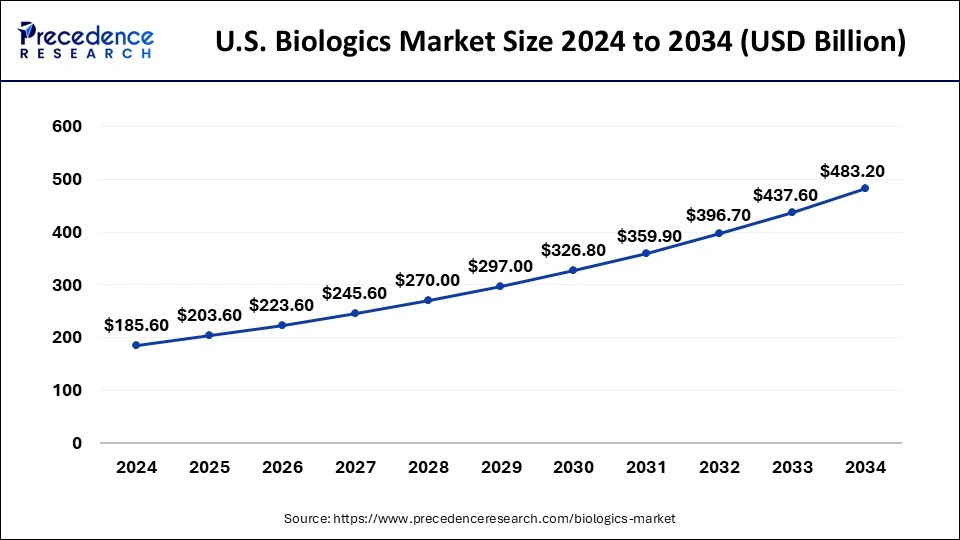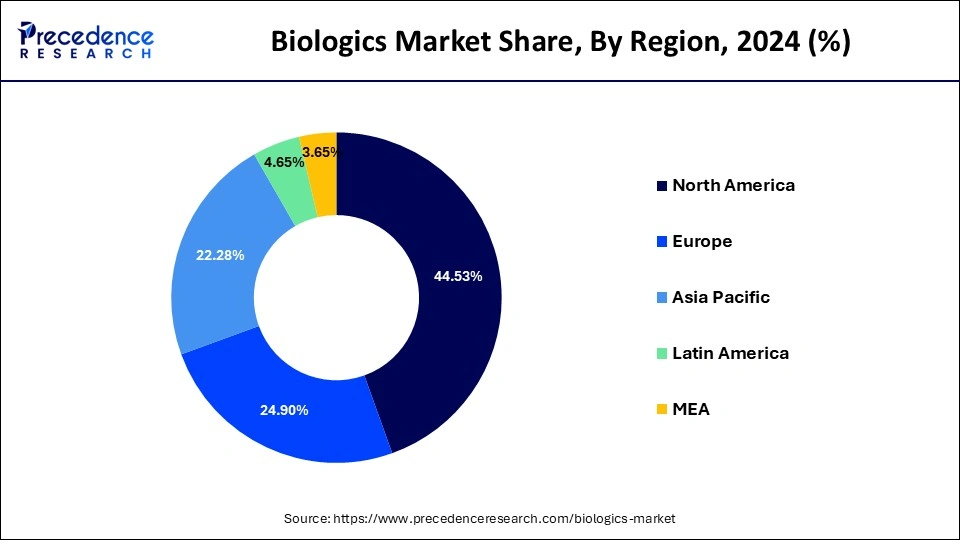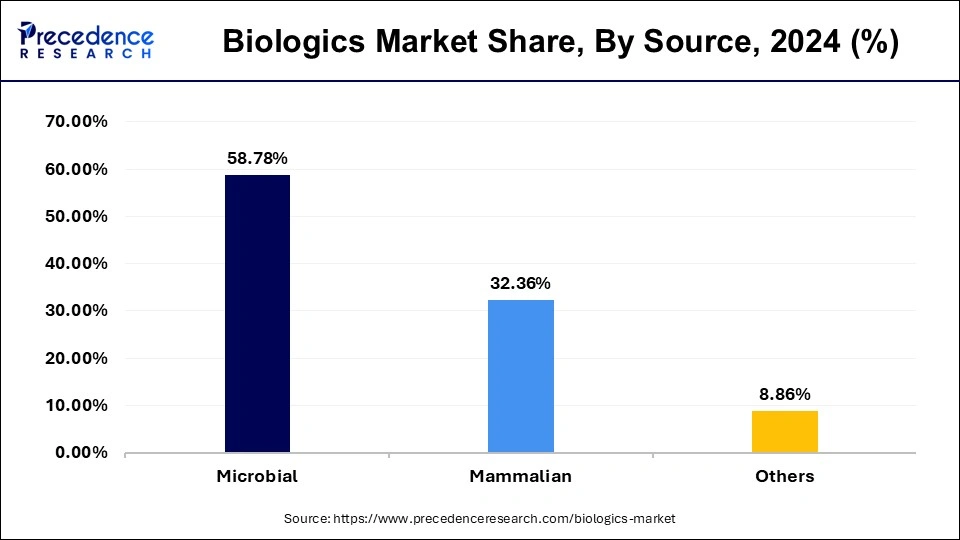August 2025
The global biologics market was calculated at USD 444.40 billion in 2024 and is predicted to increase from USD 487.00 billion in 2025 to approximately USD 1,144.20 billion by 2034, expanding at a CAGR of 9.96% from 2025 to 2034.

The U.S. biologics market size was exhibited at USD 185.60 billion in 2024 and is projected to be worth around USD 483.20 billion by 2034, growing at a CAGR of 10.08% from 2025 to 2034.

North America dominated the biologics market in 2024. This is due to the presence of many well-established players in this region. Furthermore, a larger revenue share is attributable to higher demand for disease treatment items.

Asia-Pacific, on the other hand, is expected to develop at the fastest rate during the forecast period. The regional contract manufacturers have made a upsurge of large expenditures in order to get a foothold in the capital intensive business.
Biologic is a substance made from live creatures or containing living organism components. Biologic medications are a general class of biotechnology derived pharmaceuticals originating from humans, microorganisms, and animals. Proteins that influence the activity of other proteins and cellular processes, genes that control the creation of critical proteins, modified human hormones, and cells that create substances that suppress or activate immune system components may all be found in biologic products. As biologic medications alter the way natural biologic intracellular and cellular processes work, they are sometimes referred to as biologic response modifiers.
The rise in the frequency and diagnosis of chronic diseases has demanded the availability of sophisticated diagnostics and treatment medications, which has fueled the worldwide biologics market. Biologics are drugs that have been genetically modified to target a particular portion of the immune system that causes inflammation. With the emergence of coronavirus diseases, governments in various countries are also taking steps to boost the healthcare industry and secure the supply of biologics. In addition, researchers and scientists are studying species and expression systems in order to improve the productivity of biological products. In addition, a number of pharmaceutical companies are conducting research and development to increase the efficacy of oral medications for arthritis.
Due to the fall in small molecule medication research and development productivity, biologics are expected to grow dramatically in the future years. The pharmaceutical companies are working on a variety of biologic medications in order to maintain their market dominance. When oral medications for Crohn’s diseases and rheumatoid arthritis improve in effectiveness, more moderate patients are predicted to move to branded and new therapies. In addition, new compounds offer therapeutic options for patients who have previously failed to respond to conventional treatments, and they frequently display higher protection and efficacy.
| Report Coverage | Details |
| Market Size in 2025 | USD 487.00 Billion |
| Market Size by 2034 | USD 1,144.20 Billion |
| Market Growth Rate from 2025 to 2034 | CAGR of 9.96% |
| Largest Market | North America |
| Fastest Growing Market | Asia Pacific |
| Base Year | 2024 |
| Forecast Period | 2025 to 2034 |
| Segments Covered | Source, Product, Indication, Manufacturing, Distribution Channel, and Geography |
| Regions Covered | North America, Europe, Asia-Pacific, Latin America, and Middle East & Africa |
As processing capacity improves, biopharmaceutical production capacity is likely to rise. Another example of these innovations in the employment of single use technologies is the production and manufacturing of biopharmaceuticals. Furthermore, biologists are working on developing more efficient creatures and speech processes. The development of cell lines and reagents that improve the efficacy of biological products is predicted to drive revenue growth.
The prevalence of prevalent chronic disorders as well as some countries’ comprehensive healthcare finance plans are expected to play a key role in the growth of the global biologics market. Over the projection period, improvements in the healthcare organizations together with reforms in numerous nations are projected to reflect well for the biologics market. In addition, developments in the anti-inflammatory biologics industry are expected to grow during the forecast period.
The adoption of novel biological procedures by pharmaceutical corporate giants in order to speed up their manufacturing processes is expected to result in a wide range of drug versions. The biologics industry is predicted to grow in demand due to technological advancements and less health risks.
Manufacturing is one of the most essential steps in the biologics production process, accounting for a significant portion of the worldwide biologics industry. As it represents the sector’s outsourcing and in-house operations, the mode of production is an important element to investigate. Rather than acquiring or outsourcing services, businesses choose to create their own. As a result, the percentage of biologics produced in-house has increased. Businesses are putting money into their own bioprocessing equipment.
Development of drugs for arthritis
The medical industry has a significant emphasis on the development of novel drugs and treatments. Drugs for treating rheumatic arthritis has gained a major attention in the industry, as arthritis has become one of the rapidly spreading chronic condition. According to an estimation, by 2040, 78.4 million adults will have doctor-diagnosed arthritis.
While conventional drugs such as painkillers and DMARDs are widely prescribed to control arthritis pain, they have not shown adequate results for the same. This factor brings a demand for efficient medicine for arthritis. Biologics are derived from living organisms and target specific components of the immune system that are involved in inflammatory processes. As biologics have started gaining acceptance among healthcare professionals, there has been an increase in their adoption for arthritis treatment. Moreover, the ongoing commitment towards the development of arthritis treatment promotes the growth of the market by acting as a driving factor.
Rising research and development activities
Research and development activities in the pharmaceutical and biotechnology industries lead to the discovery and development of new and innovative range of therapeutic options for numerous medical conditions that contain a wide range of biologics. Biologics can be designed to target specific molecular pathways and receptors, making them more precise and personalized in their therapeutic approach.
Additionally, research and development activities are being done for developing biosimilars, that are similar to the approved biologics drugs. Multiple research laboratories demand biologics for the comparison purpose during the development of biosimilars. All these elements associated with research and development activities act as a driver for the growth of the biologics market.
Integration of biosimilars in the industry
Biosimilars are highly approved materials that are similar to biologics. Biosimilars are typically introduced at lower prices as compared to biologics, the rapidly expiring patents of biologics open a wide set of opportunities for biosimilars. The integration of biosimilars in the industry can lead to a reduction in the market share for biologics. The reduced profit margins for biologics are observed to shift the focus towards biosimilars. This element acts as a major restraint for the market.
High development cost
Biologic developers or manufacturers face challenges due to the high capital investment required for the development of biologics, the development of biologics is a lengthy and time-consuming process. It can take years from the initial investment to the market approval. This extended timeline increases the overall costs as it requires continuous clinical trials, research-based activities and manufacturing practices. This factor can limit manufacturers from entering into the business which hampers the growth of the market. Thereby, considered a restraint for the market.
Rising demand for personalized medicine
Personalized medicine often depends on the targeted therapies, such therapies are designed to address specific molecular targets in the human body. Personalized medicine also relies heavily on the identification of biomarkers. Biologics play a major role in the development of diagnostic tools such as biomarkers. This can help in diagnosing diseases. With personalized medicine, there is an increasing demand for customized treatments to meet specific needs of an individual. Biologics can be modified and engineered to fit these requirements which leads to more effective and patient-centric treatment options. Thus, the demand for personalized medicine is observed to create opportunities for the market.
Market Challenge
Regulatory hurdles
The biologics market is expanding, many players are investing in research and development on an international level. Whereas the lack of harmonization among regulatory agencies from different countries may create a challenge for the growth of the market. Moreover, certain uncertainties in the regulatory framework pose a challenge for the market. As biologics continue to advance, regulatory agencies may face uncertainty in defining appropriate regulatory pathways. All these factors including scientific and technological challenges hamper the growth of the market by limiting the entry of manufacturers as well as researchers.
In 2024, the microbial segment dominated the biologics market. Due to the vast number of pharmaceuticals produced by these products, microbial expression systems had the highest revenue generation. E. coli and yeast are commonly included in microbial expression systems.

The mammalian segment is predicted to develop at the quickest rate in the future years. Platelet derived growth factor, recombinant insulin, and recombinant interferon is some of the products that have been generated using these expression systems.
Biologics Market Revenue, By Source, 2022-2024 (USD Billion)
| Source | 2022 | 2023 | 2024 |
| Microbial | 221.10 | 239.40 | 261.20 |
| Mammalian | 119.30 | 130.50 | 143.80 |
| Others | 33.80 | 36.30 | 39.40 |
In 2024, the monoclonal antibodies (MABs) segment dominated the biologics market. Due to the increased use of this class of pharmaceuticals in several therapeutic areas, monoclonal antibodies dominated the market with the biggest revenue share. Monoclonal antibodies allow sick cells to be targeted without hurting good cells.
The vaccines segment, on the other hand, is predicted to develop at the quickest rate in the future years. Due to its use as a prophylactic measure in infectious disorders, vaccines are expected to expand at the fastest rate in the next years.
Biologics Market Revenue, By Product, 2022-2024 (USD Billion)
| Product | 2022 | 2023 | 2024 |
| Monoclonal Antibody | 211.1 | 229.4 | 251.2 |
| Immune Checkpoint Inhibitors | 116.5 | 126.5 | 138.4 |
| Biosimilar | 71.9 | 78.7 | 86.8 |
| Antibody-Drug Conjugates (ADC) | 22.6 | 24.2 | 26.1 |
| Recombinant Insulin | 41.4 | 44.9 | 49.0 |
| Vaccine | 76.0 | 81.3 | 87.6 |
| Human Growth Hormone | 6.4 | 7.0 | 7.7 |
| Cell & Gene Therapy | 23.0 | 26.0 | 29.5 |
| Recombinant Enzyme | 3.6 | 4.0 | 4.4 |
| Interferon | 9.3 | 10.0 | 10.9 |
| Others | 3.5 | 3.7 | 4.0 |
In 2024, the oncology segment dominated the biologics market. This is attributed to the increased incidence of cancer combined with the presence of many research and development programs.
The cardiovascular diseases segment, on the other hand, is predicted to develop at the quickest rate in the future years. This is attributed to the rising prevalence of heart and blood vessel diseases.
Biologics Market Revenue, By Disease, 2022-2024 (USD Billion)
| Disease | 2022 | 2023 | 2024 |
| Oncology | 111.2 | 122.0 | 134.9 |
| Infectious Diseases | 63.1 | 68.3 | 74.5 |
| Immunological Disorders | 49.0 | 52.8 | 57.4 |
| Cardiovascular Disorders | 88.8 | 96.7 | 106.1 |
| Hematological Disorders | 35.3 | 37.9 | 41.0 |
| Others | 26.8 | 28.5 | 30.4 |
By Source
By Product
By Indication
By Manufacturing
By Distribution Channel
By Geography
For inquiries regarding discounts, bulk purchases, or customization requests, please contact us at sales@precedenceresearch.com
No cookie-cutter, only authentic analysis – take the 1st step to become a Precedence Research client
August 2025
June 2025
July 2025
July 2025